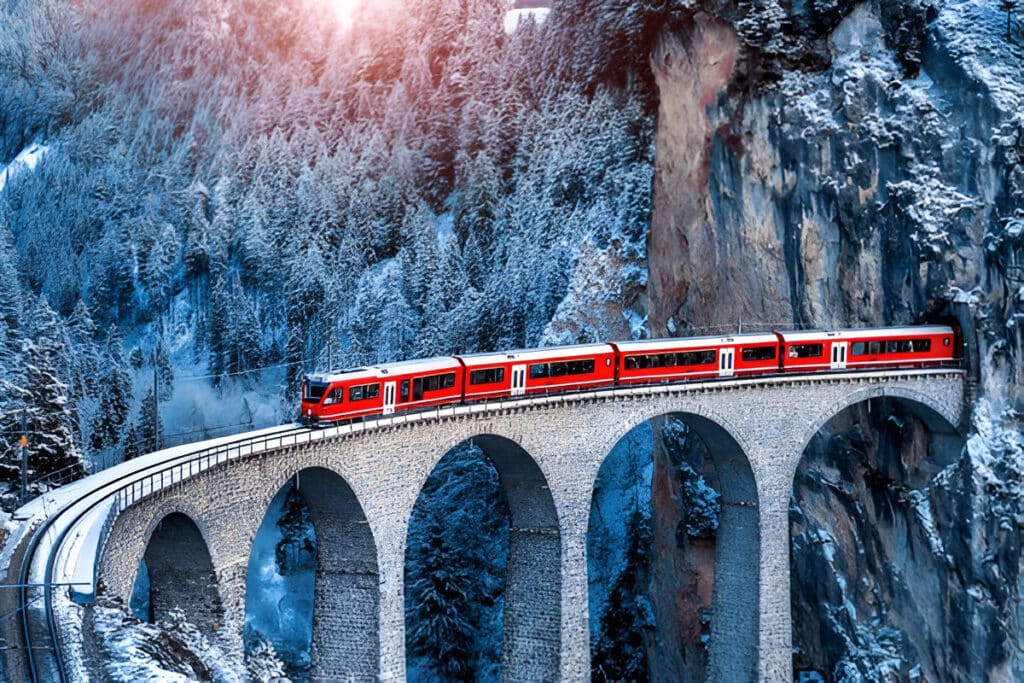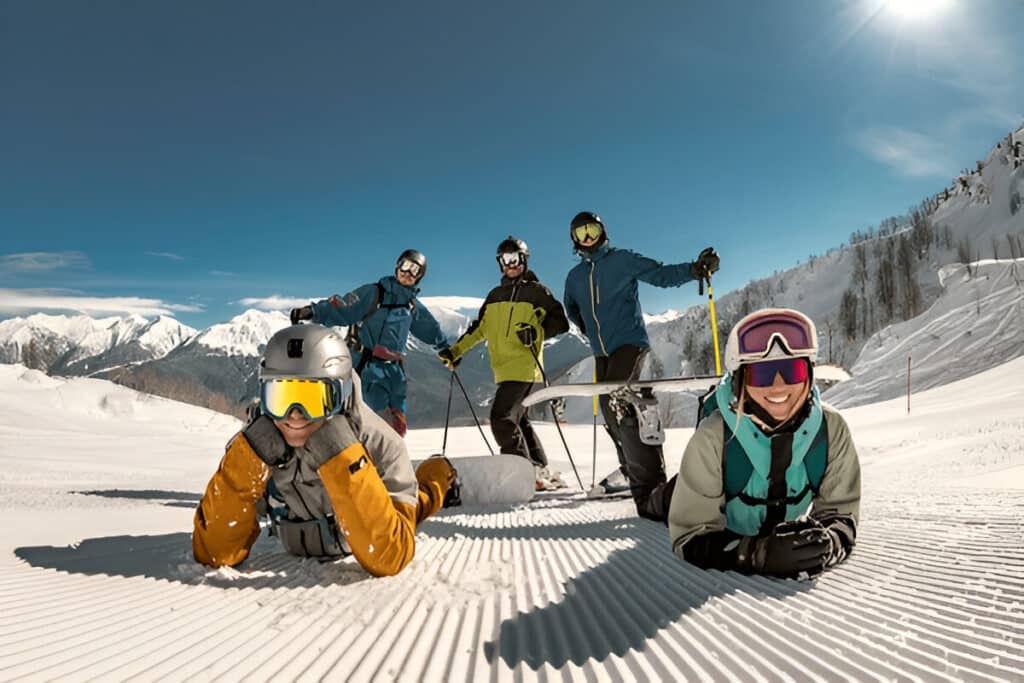Alpine tourism refers to travel and recreational activities centered around the mountainous regions of the Alps, which are typically characterized by high elevations, snowy landscapes, and scenic vistas. This type of tourism includes activities such as:
- Skiing and Snowboarding: The most popular activities in the winter months.
- Hiking and Mountaineering: Trekking and climbing during warmer months, with trails offering views of alpine flora and fauna.
- Nature and Wildlife Viewing: Observing the unique flora and fauna found in alpine environments.
- Mountain Biking: Riding on specialized trails designed for mountain biking.
- Spa and Wellness Tourism: Many alpine resorts offer wellness treatments, hot springs, and relaxation experiences.
- Cultural Tourism: Exploring the local culture, villages, and cuisine of alpine regions.
Alpine tourism is particularly prevalent in countries like Switzerland, France, Austria, and Italy, where the natural landscape and infrastructure support a wide variety of outdoor and leisure activities.
Alpine, as opposed to mountain tourism, concerns itself with the phenomenon which takes place within the perimeters of the European Alps. The development follows the classical pattern of destination lifecycles which add up to a general
alpine tourism pattern.
During the first phase, the Alps were visited by pilgrims and adventurers pursuing exploratory activities. Its next phase took place in the core alpine regions of Austria, Italy, France, and Switzerland, drawing tourists from adjoining regions in tandem with skiing and hiking as popular sporting activities.
At the same time, numerous alpine clubs and refuges have been initiated, followed by the construction of cable cars and ski lifts. Alpine healthcare carried out mainly in alpine sanatoria was added as a third product.
Throughout the war and interwar periods, alpine tourism grew moderately. Starting in the 1960s, many destinations became exposed to internationalization, and mass tourism began in the third phase of the lifecycle with a high growth of arrivals, coming from new and emerging markets such as Russia, China, India, and Japan.
By the 1980s, mass tourism had taken a hold in many alpine destinations, signaling the first signs of ecological, social, and cultural decay. Economic degradations which followed were in part the result of traditional basic alpine products such as hiking, healthcare, and alpine skiing which become outdated in the face of shifting
leisure preferences and demographic changes.
Such transformation resulted from natural (ecological) and built (social and cultural) capacity constraints in the destination. Climate change and the retreat of glaciers are about to further aggravate the sustainable competitive advantage
of many alpine destinations.
Alpine Tourism Activities

Alpine tourism offers a wide range of activities that attract nature enthusiasts, adventure seekers, and those looking for relaxation in stunning mountain landscapes. Depending on the time of year and the region, here are some popular alpine tourism activities:
Winter Activities:
- Skiing & Snowboarding: The most popular alpine activity, with options for all levels, from beginners to expert skiers.
- Snowshoeing: A great way to explore the snow-covered landscape at a slower pace.
- Sledging: A fun and family-friendly way to enjoy the snow, often available on designated tracks.
- Ice Climbing: For adrenaline junkies, scaling frozen waterfalls or ice-covered rock faces.
- Winter Hiking: Trails suited for winter hiking with proper equipment like crampons.
- Dog Sledding: A unique way to travel through the snow while enjoying the alpine scenery.
- Avalanche Safety Training: For those heading off-piste or skiing in avalanche-prone areas.
- Igloo Building: Some regions offer courses where you can learn to build your own igloo.
Summer Activities:
- Hiking & Trekking: The alpine trails offer everything from gentle walks to challenging multi-day treks.
- Mountain Biking: Trails for all skill levels, including downhill, cross-country, and bike parks.
- Paragliding: Soar above the mountains and get a bird’s-eye view of the stunning landscapes.
- Climbing: Alpine rock climbing for different skill levels, with some areas known for world-class routes.
- Canoeing & Kayaking: On alpine lakes or mountain rivers, this can be both relaxing and adventurous.
- Camping: Enjoy camping in the wilderness, with some alpine campsites offering high-altitude views.
- Alpine Wildflower Viewing: In summer, alpine meadows come alive with wildflowers, offering excellent photo opportunities.
- Fishing: Trout and other fish in alpine lakes or mountain streams.
Year-Round Activities:
- Spa & Wellness: Many alpine resorts offer wellness centers with thermal baths, saunas, and spa treatments to relax after an active day.
- Cultural Tours: Explore alpine villages, their traditions, architecture, and local cuisine.
- Photography: The scenic vistas, wildlife, and changing seasons make the Alps a photographer’s paradise.
- Culinary Experiences: Alpine regions are famous for their local dishes, often involving cheeses, meats, and regional wines.
- Horseback Riding: Many mountain regions offer horseback riding tours, especially in the valleys and lower mountain areas.
Specialized Activities:
- Alpine Ski Touring: Skiers climb up the mountain with specialized gear before descending off-piste.
- Glacier Hiking: Explore high-altitude glaciers with experienced guides.
- Zip Lining: Some alpine regions have zip lines that take you soaring through the mountain air.
- Hot Air Ballooning: Offering breathtaking aerial views of the mountain ranges.
These activities provide a broad spectrum of experiences, from intense physical challenges to tranquil moments of relaxation, all set in the mesmerizing alpine environment.
What is Alpine Touring

Alpine touring (also known as backcountry skiing or randonnée skiing) refers to a form of skiing where participants ascend a mountain using specialized equipment, then ski back down on ungroomed, off-piste terrain. Unlike traditional alpine skiing, where skiers rely on ski lifts to reach the top, alpine touring allows individuals to climb to the summit or a high point on skis before descending.
Alpine touring is popular for those seeking an adventurous, nature-based experience, away from the crowds and controlled environments of ski resorts. However, it also requires knowledge of avalanche safety, navigation, and mountain conditions due to the risks associated with backcountry travel.
How many Tourists visit the Alps each year

The Alps are one of the most popular tourist destinations in the world, attracting millions of visitors each year. The exact number of tourists can vary based on factors like the season, economic conditions, and global events, but here are some estimates:
- Annual Visitors: The Alps generally receive around 120 million visitors per year across all the countries that share the mountain range (France, Switzerland, Austria, Italy, Germany, and Slovenia). This includes both summer and winter tourists.
- Winter Season: The winter months (December to March) attract a significant portion of the tourists, primarily for skiing and snowboarding. Countries like France, Switzerland, and Austria have some of the most famous ski resorts in the world.
- Summer Season: During the warmer months (June to September), visitors flock to the Alps for hiking, cycling, and other outdoor activities. The summer season typically sees fewer visitors than winter, but still a substantial number.
- Country Breakdown:
- France: The French Alps, including iconic regions like Chamonix, attract millions each year. France alone sees approximately 50-60 million tourists annually.
- Switzerland: Switzerland’s alpine tourism, including regions like Zermatt and St. Moritz, draws around 10-15 million visitors per year.
- Austria: Austria’s Alpine regions are also major attractions, bringing in approximately 25 million tourists annually.